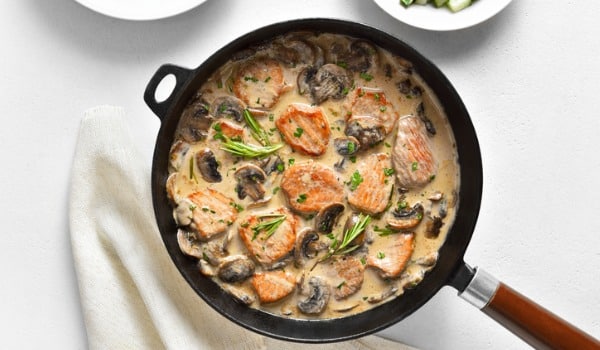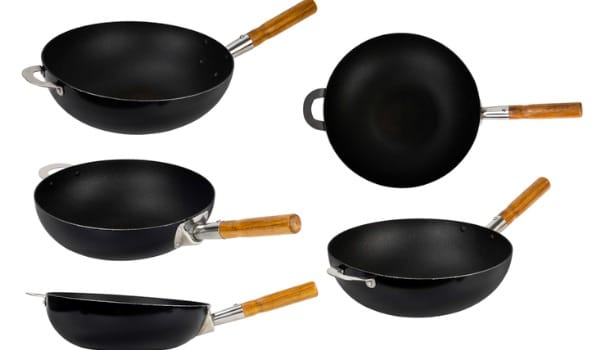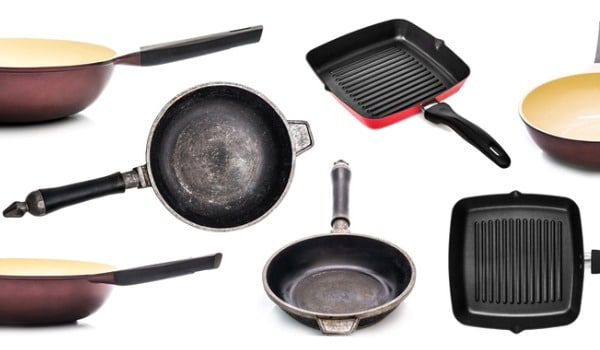Have you ever found yourself standing in the kitchen, staring at a skillet and wondering: what exactly is this thing used for? Well, fear not my fellow culinary enthusiasts, because today we are diving deep into the world of skillets. These versatile kitchen tools have been a staple in households for centuries, but their uses go far beyond your typical frying pan. From searing steaks to baking scrumptious desserts, skillets are the unsung heroes of the kitchen. So buckle up and join me on this flavorful journey as we uncover the secrets of what skillets are truly used for.
What is a skillet?

A skillet, also known as a frying pan or frypan, is a flat-bottomed cooking utensil with sloping sides and a long handle used for frying, searing, sautéing, and various other cooking techniques. Skillets are typically made from materials like cast iron, stainless steel, or non-stick-coated aluminum and come in various sizes to accommodate different cooking needs. Also, They are a versatile and essential kitchen tool for preparing a wide range of dishes, from breakfast favorites like eggs and bacon to stir-fries and more.
What types of skillets are available?

Several types of skillets are available to suit various cooking preferences and needs. Cast iron skillets are known for their excellent heat retention and durability. Non-stick skillets have a coating that makes cooking and cleaning easier. Stainless steel skillets are known for their versatility and resistance to staining. Copper skillets offer excellent heat conductivity and precise temperature control. Additionally, there are electric skillets with built-in heating elements and specialty skillets like woks for stir-frying. Each type of skillet has its unique advantages, making it essential to choose the one that best matches your cooking style and requirements.
Cooking Methods

Frying
Frying involves submerging food in hot oil or fat. There are two common methods: deep frying (completely submerging the food) and shallow frying (partially submerging the food). It results in a crispy, golden exterior.
Sautéing
Sautéing is a method where food is quickly cooked in a small amount of oil or butter over high heat in a shallow pan. It’s often used for vegetables, meat, or seafood and results in a flavorful, lightly browned surface.
Stir-frying
Stir-frying is a quick cooking method where small pieces of food are constantly stirred and cooked in a small amount of oil over high heat. Also, It’s commonly associated with Asian cuisine and retains the natural flavors and textures of the ingredients.
Pan-searing
Pan-searing involves cooking food, usually meat, in a hot, dry pan without much oil. The goal is to create a browned, flavorful crust on the exterior while keeping the inside moist and tender.
Baking
Baking is a dry heat method that is used in ovens. It’s typically employed for items like bread, cakes, casseroles, and roasts. Baking surrounds the food with dry, indirect heat, resulting in even cooking.
Roasting
Roasting is similar to baking but typically used for larger cuts of meat and poultry. It involves cooking in an oven at a higher temperature to create a browned, crispy exterior while keeping the interior moist and flavorful.
Braising
Braising is a combination cooking method that involves searing food in a pan and then simmering it slowly in a flavorful liquid, often in a covered pot. It’s ideal for tough cuts of meat or dishes like stews.
Poaching
Poaching is a gentle cooking method in which food is simmered in a liquid, typically water or broth. It’s often used for delicate items like eggs, fish, or fruits and is known for preserving the food’s natural flavors and tenderness.
Types of Skillets

Cast iron skillet
Cast iron skillets are known for their excellent heat retention and even heating. Also, They are versatile and can be used on stovetops or in the oven. They require proper seasoning to maintain their non-stick properties and prevent rusting.
Non-stick skillet
Non-stick skillets have a non-stick coating that makes them ideal for cooking items like eggs, pancakes, and delicate foods. They require less oil or fat for cooking and are easy to clean, but the non-stick coating can wear out over time.
Stainless steel skillet
Stainless steel skillets are durable, resistant to staining, and do not react with acidic foods. They are great for browning and searing, but they can be prone to food sticking if not properly preheated and lubricated.
Copper skillet
Copper skillets have excellent heat conductivity, allowing for precise temperature control. They are often lined with stainless steel to prevent reactions with food, but they can be quite expensive.
Carbon steel skillet
Carbon steel skillets are similar to cast iron skillets in terms of heat retention and versatility. They become naturally non-stick with proper seasoning and are popular in various cuisines, especially for tasks like stir-frying and sautéing.
Electric skillet
An electric skillet is a portable, plug-in appliance that has a flat cooking surface. It allows for controlled cooking temperatures and is useful for dishes that require consistent heating, like frying, simmering, or griddling.
Common Uses

- Cooking breakfast items: This includes frying eggs, making omelets, cooking bacon, and preparing pancakes or waffles.
- Preparing stir-fries and one-pan dishes: Stir-fries involve quickly cooking a mix of vegetables, meat, and sauce in a pan or wok, while one-pan dishes often combine various ingredients in a single pan for a simple, flavorful meal.
- Searing and browning meats: Searing involves quickly cooking the surface of meat at high heat to develop a flavorful crust, while browning meats is done to add color and flavor to dishes like stews or braises.
- Baking desserts and cornbread: Baking is used for a wide range of sweet treats and bread, including cookies, cakes, pies, and cornbread.
- Roasting vegetables: Roasting involves cooking vegetables in the oven with oil and seasonings until they become tender and develop a delicious caramelized exterior.
- Simmering sauces and stews: Simmering is a gentle cooking method that’s used to develop flavors in sauces, soups, and stews by keeping them at a low, consistent temperature.
- Poaching eggs and fish: Poaching is a delicate cooking technique where food, like eggs or fish, is gently simmered in water or a flavorful liquid until it’s cooked to perfection.
- Reheating leftovers: Using a stovetop or oven to reheat leftovers can help maintain their flavor and texture better than a microwave.
These cooking methods cover a wide range of culinary possibilities and are fundamental in various types of cuisine and meal preparation.
Advantages of Skillets

Heat retention and distribution
Skillets are often made from materials that excel in retaining and distributing heat evenly. Cast iron skillets, for instance, are renowned for their excellent heat retention, allowing them to stay hot for an extended period even after the heat source is reduced. This even distribution of heat helps in achieving consistent cooking results and is essential for tasks like searing, browning, and achieving that perfect crust on meats or other dishes.
Easy to clean and maintain
Many skillets come with non-stick coatings or are made from materials like stainless steel, which are relatively easy to clean. Non-stick surfaces reduce the likelihood of food sticking to the pan, making cleanup a breeze. However, Proper maintenance, like seasoning cast iron skillets, ensures their longevity and non-stick properties.
Versatility in cooking methods
Skillets are incredibly versatile and can be used for a wide range of cooking methods. You can use them for frying, sautéing, searing, stir-frying, shallow frying, making frittatas, and more. However, The versatility of skillets allows you to experiment with various recipes and cooking techniques.
Durability
Skillets are often built to withstand high temperatures and the rigors of everyday cooking. Cast iron skillets, in particular, are known for their exceptional durability and can last for generations if properly cared for. Stainless steel skillets are resistant to staining, pitting, and rust, adding to their longevity.
Suitable for various heat sources
Skillets are compatible with a wide range of heat sources, including gas, electric, induction stovetops, ovens, and even open flames. This adaptability makes skillets an excellent choice for different cooking scenarios, whether you’re preparing a quick stovetop meal, slow-braising in the oven, or cooking over a campfire.
Skillet Tips and Care

Seasoning cast iron skillets
Seasoning cast iron skillets is crucial to maintain their non-sticks properties and prevent rust. To season, apply a thin layer of vegetable oil or shortening to the skillet’s interior and heat it in the oven at 350-400°F for about an hour. Repeat this process a few times to build up a good seasoning layer.
Avoiding overheating non-stick skillets
Avoid overheating non-stick skillets to prevent the release of harmful fumes and damage to the non-stick coating. Use low to medium heat settings and never preheat an empty non-stick skillet. Also, It’s best to add a little oil or butter to aid in cooking and protect the non-stick surface.
Proper cleaning and storage
Proper cleaning and storage are essential for both cast iron and non-stick skillets. For cast iron, avoid using soap and abrasive scrubbers; instead, clean it with a stiff brush or a gentle sponge, dry it thoroughly, and apply a thin layer of oil after each use. Non-stick skillets should be cleaned with a soft sponge and mild detergent. Store both types of skillets in a dry place to prevent rust or damage to the non-stick coating.
Maintenance for longevity
Maintenance for longevity involves periodic checks for any signs of wear or damage. With cast iron, if the seasoning starts to wear off, re-season the skillet. For non-stick skillets, replace them if the coating becomes significantly damaged or starts peeling. Regular care and maintenance will ensure that your skillets last for many years and serve you well in the kitchen.
Conclusion
Skillets are incredibly versatile and useful tools in the kitchen. From frying eggs to sautéing vegetables, they can handle a wide range of cooking tasks with ease. Skillets are also great for browning meat and creating delicious pan sauces. Whether you’re a professional chef or a home cook, having a quality skillet in your kitchen is essential. So next time you’re considering adding or upgrading your cookware, don’t forget to invest in a high-quality skillet. It will surely become one of your most used and beloved kitchen tools.




